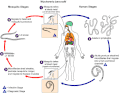Fájl:Wuchereria bancrofti LifeCycle.gif
Wuchereria_bancrofti_LifeCycle.gif (513 × 435 képpont, fájlméret: 33 KB, MIME-típus: image/gif)
Fájltörténet
Kattints egy időpontra, hogy a fájl akkori állapotát láthasd.
| Dátum/idő | Bélyegkép | Felbontás | Feltöltő | Megjegyzés | |
|---|---|---|---|---|---|
| aktuális | 2008. november 5., 16:15 |  | 513 × 435 (33 KB) | Lycaon | Watermark removed |
| 2006. május 14., 23:02 |  | 513 × 435 (36 KB) | Patho | {{Information| |Description=Filariasis [Brugia malayi] [Brugia timori] [Loa loa] [Mansonella ozzardi] [Mansonella perstans] [Mansonella streptocerca] [Onchocerca volvulus] [Wuchereria bancrofti] Life cycle of Wuchereria bancrofti Different species |
Fájlhasználat
Az alábbi lap használja ezt a fájlt:
Globális fájlhasználat
A következő wikik használják ezt a fájlt:
- Használata itt: ceb.wikipedia.org
- Használata itt: de.wikipedia.org
- Használata itt: de.wikibooks.org
- Használata itt: en.wikipedia.org
- Használata itt: fr.wikipedia.org
- Használata itt: nn.wikipedia.org
- Használata itt: pl.wikipedia.org
- Használata itt: sv.wikipedia.org

